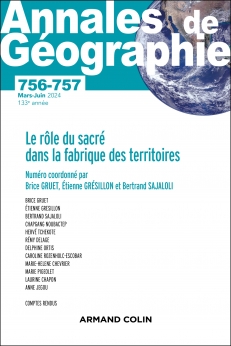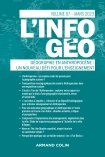
ANNALES DE GÉOGRAPHIE N°756-757 (2-3/2024)
Pour acheter ce numéro, contactez-nous
Recevez les numéros de l'année en cours et accédez à l'intégralité des articles en ligne.
La prise de conscience de la finitude spatio-temporelle du monde (crises écologiques, climatiques, sanitaires...), l’anxiété qu’elle crée chez les êtres humains, en particulier en Europe, favorisent le retour du sacré et sa fixation sur des objets environnementaux. Pour intégrer ce qui relie la nature et la culture, les spiritualités offrent à la fois un précieux recueil d’expériences et une boîte à outils pour dépasser la crise actuelle. La force de la religion réside en ce qu’elle traite des relations entre les vivants, entre ces vivants et l’univers, et ce du quotidien depuis le début jusqu’à la fin des temps. Cause avancée et remède proclamé de la crise écologique, le sacré transforme un discours scientifique en une éthique spirituelle accessible pour tous, avec des propositions sur les raisons du monde (création), des solutions (encyclique Laudato Si) et un univers des possibles. Si le vivant et Gaïa ouvrent des questionnements spirituels sur l’univers, et ce de moins en moins en marge du domaine scientifique stricto sensu, le sacré et notamment la redécouverte des cultures rurales et populaires, propose une sorte d’ontologie alternative face aux visions plus institutionnelles de la nature.
Awareness of the finiteness of the world in space and time (ecological, climatic and health crises, etc.) and the anxiety it creates in human beings, particularly in Europe, are encouraging a return to the sacred and a focus on environmental objects. When it comes to integrating the links between nature and culture, spirituality offers both a valuable compendium of experience and a toolbox for overcoming the current crisis. The strength of religion lies in the fact that it deals with the relationships between living beings, and between living beings and the universe, from the beginning to the end of time. As both cause and remedy for the ecological crisis, the sacred transforms a scientific discourse into a spiritual ethic accessible to all, with an idea of the reasons for the world (creation), solutions and a universe of possibilities (Laudato Si). If living beings and Gaia are opening up spiritual questions about the universe, outside the realm of science in the strict sense of the term, then the sacred, and in particular the rediscovery of rural and popular cultures, offers a kind of alternative ontology to the more institutional visions of nature.

